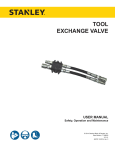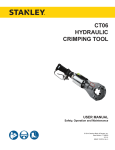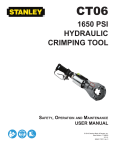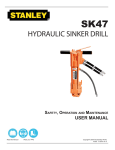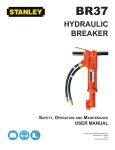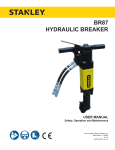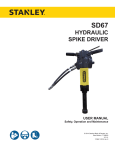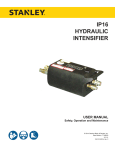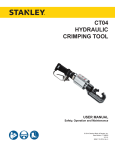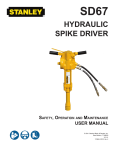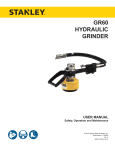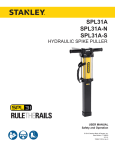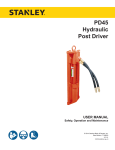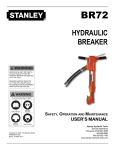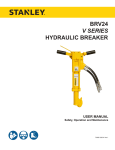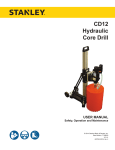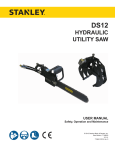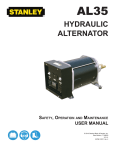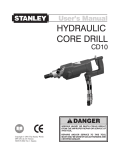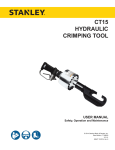Download SK47 User Manual 10-2014 V7
Transcript
SK47 HYDRAULIC SINKER DRILL USER MANUAL Safety, Operation and Maintenance © 2014 Stanley Black & Decker, Inc. New Britain, CT 06053 U.S.A. 10323 10/2014 Ver. 7 TABLE OF CONTENTS SAFETY SYMBOLS...................................................................................................................................................4 SAFETY PRECAUTIONS...........................................................................................................................................5 TOOL STICKERS & TAGS.........................................................................................................................................6 HOSE TYPES.............................................................................................................................................................7 HOSE RECOMMENDATIONS...................................................................................................................................8 FIGURE 1. TYPICAL HOSE CONNECTIONS........................................................................................................8 HTMA REQUIREMENTS............................................................................................................................................9 OPERATION.............................................................................................................................................................10 TOOL PROTECTION & CARE.................................................................................................................................12 CHARGING THE ACCUMULATOR..........................................................................................................................13 FIGURE 2. CHARGING THE ACCUMULATOR....................................................................................................14 TROUBLESHOOTING.............................................................................................................................................15 SPECIFICATIONS....................................................................................................................................................16 ACCESSORIES.......................................................................................................................................................16 SK47 PARTS ILLUSTRATION.................................................................................................................................17 SK47 PARTS LIST...................................................................................................................................................18 IMPORTANT To fill out a Product Warranty Validation form, and for information on your warranty, visit Stanleyhydraulics.com and select the Company tab, Warranty. (NOTE: The warranty Validation record must be submitted to validate the warranty). SERVICING: This manual contains safety, operation, and routine maintenance instructions. Stanley Hydraulic Tools recommends that servicing of hydraulic tools, other than routine maintenance, must be performed by an authorized and certified dealer. Please read the following warning. WARNING SERIOUS INJURY OR DEATH COULD RESULT FROM THE IMPROPER REPAIR OR SERVICE OF THIS TOOL. REPAIRS AND / OR SERVICE TO THIS TOOL MUST ONLY BE DONE BY AN AUTHORIZED AND CERTIFIED DEALER. For the nearest authorized and certified dealer, call Stanley Hydraulic Tools at the number listed on the back of this manual and ask for a Customer Service Representative. SK47 User Manual ◄ 3 SAFETY SYMBOLS Safety symbols and signal words, as shown below, are used to emphasize all operator, maintenance and repair actions which, if not strictly followed, could result in a life-threatening situation, bodily injury or damage to equipment. This is the safety alert symbol. It is used to alert you to potential personal injury hazards. Obey all safety messages that follow this symbol to avoid possible injury or death. DANGER This safety alert and signal word indicate an imminently hazardous situation which, if not avoided, will result in death or serious injury. WARNING This safety alert and signal word indicate a potentially hazardous situation which, if not avoided, could result in death or serious injury. CAUTION This safety alert and signal word indicate a potentially hazardous situation which, if not avoided, could result in death or serious injury. CAUTION This signal word indicates a potentially hazardous situation which, if not avoided, may result in property damage. NOTICE This signal word indicates a situation which, if not avoided, will result in damage to the equipment. IMPORTANT This signal word indicates a situation which, if not avoided, may result in damage to the equipment. Always observe safety symbols. They are included for your safety and for the protection of the tool. LOCAL SAFETY REGULATIONS Enter any local safety regulations here. Keep these instructions in an area accessible to the operator and maintenance personnel. 4 ► SK47 User Manual SAFETY PRECAUTIONS Tool operators and maintenance personnel must always comply with the safety precautions given in this manual and on the stickers and tags attached to the tool and hose. • Do not operate a damaged, improperly adjusted, or incompletely assembled tool. • These safety precautions are given for your safety. Review them carefully before operating the tool and before performing general maintenance or repairs. Do not weld, cut with an acetylene torch, or hardface the tool bit. • To avoid personal injury or equipment damage, all tool repair, maintenance and service must only be performed by authorized and properly trained personnel. • Do not exceed the rated limits of the tool or use the tool for applications beyond its design capacity. • Always keep critical tool markings, such as labels and warning stickers legible. • Always replace parts with replacement parts recommended by Stanley Hydraulic Tools. • Check fastener tightness often and before each use daily. • Never operate the tool if you cannot be sure that underground utilities are not present. • Do not wear loose fitting clothing when operating the tool. • Warning: Use of this tool on certain materials during demolition could generate dust potentially containing a variety of hazardous substances such as asbestos, silica or lead. Inhalation of dust containing these or other hazardous substances could result in serious injury, cancer or death. Protect yourself and those around you. Research and understand the materials you are cutting. Follow correct safety procedures and comply with all applicable national, state or provisional health and safety regulations relating to them, including, if appropriate arranging for the safe disposal of the materials by a qualified person. The SK47 Hydraulic Sinker Drill will provide safe and dependable service if operated in accordance with the instructions given in this manual. Read and understand this manual and any stickers and tags attached to the tool and hoses before operation. Failure to do so could result in personal injury or equipment damage. • Operator must start in a work area without bystanders. The operator must be familiar with all prohibited work areas such as excessive slopes and dangerous terrain conditions. • Establish a training program for all operators to ensure safe operation. • Do not operate the tool unless thoroughly trained or under the supervision of an instructor. • Always wear safety equipment such as goggles, ear, head and breathing protection, and safety shoes at all times when operating the tool. • Do not inspect or clean the tool while the hydraulic power source is connected. Accidental engagement of the tool can cause serious injury. • Supply hoses must have a minimum working pressure rating of 2500 psi/175 bar. • The hydraulic circuit control valve must be in the OFF position when coupling or uncoupling the tool. Wipe all couplers clean before connecting. Use only lint-free cloths. Failure to do so may result in damage to the quick couplers and cause overheating of the hydraulic system. • Do not operate the tool at oil temperatures above 140 °F/60 °C. Operation at higher oil temperatures can cause operator discomfort and may damage the tool. SK47 User Manual ◄ 5 TOOL STICKERS & TAGS SK47 SINKER DRILL FLOW: 7-9 GPM/26-34 LPM PRESS: 1500-2000 PSI ACCUMULATOR CHARGE: 600 PSI NITROGEN Stanley Hydraulic Tools Division of The Stanley Works 3810 SE Naef Road Milwaukie, Oregon 97267 USA 08103 SK47 Name Tag NOTE: THE INFORMATION LISTED ON THE STICKERS SHOWN, MUST BE LEGIBLE AT ALL TIMES. REPLACE DECALS IF THEY BECOME WORN OR DAMAGED. REPLACEMENTS ARE AVAILABLE FROM YOUR LOCAL STANLEY DISTRIBUTOR. The safety tag (P/N 15875) at right is attached to the tool when shipped from the factory. Read and understand the safety instructions listed on this tag before removal. We suggest you retain this tag and attach it to the tool when not in use. D A N G E R 1. FAILURE TO USE HYDRAULIC HOSE LABELED AND CERTIFIED AS NON-CONDUCTIVE WHEN USING HYDRAULIC TOOLS ON OR NEAR ELECTRICAL LINES MAY RESULT IN DEATH OR SERIOUS INJURY. BEFORE USING HOSE LABELED AND CERTIFIED AS NONCONDUCTIVE ON OR NEAR ELECTRIC LINES BE SURE THE HOSE IS MAINTAINED AS NON-CONDUCTIVE. THE HOSE SHOULD BE REGULARLY TESTED FOR ELECTRIC CURRENT LEAKAGE IN ACCORDANCE WITH YOUR SAFETY DEPARTMENT INSTRUCTIONS. 2. A HYDRAULIC LEAK OR BURST MAY CAUSE OIL INJECTION INTO THE BODY OR CAUSE OTHER SEVERE PERSONAL INJURY. A. DO NOT EXCEED SPECIFIED FLOW AND PRESSURE FOR THIS TOOL. EXCESS FLOW OR PRESSURE MAY CAUSE A LEAK OR BURST. B. DO NOT EXCEED RATED WORKING PRESSURE OF HYDRAULIC HOSE USED WITH THIS TOOL. EXCESS PRESSURE MAY CAUSE A LEAK OR BURST. C. CHECK TOOL HOSE COUPLERS AND CONNECTORS DAILY FOR LEAKS. DO NOT FEEL FOR LEAKS WITH YOUR HANDS. CONTACT WITH A LEAK MAY RESULT IN SEVERE PERSONAL INJURY. D A N G E R D. DO NOT LIFT OR CARRY TOOL BY THE HOSES. DO NOT ABUSE HOSE. DO NOT USE KINKED, TORN OR DAMAGED HOSE. 3. MAKE SURE HYDRAULIC HOSES ARE PROPERLY CONNECTED TO THE TOOL BEFORE PRESSURING SYSTEM. SYSTEM PRESSURE HOSE MUST ALWAYS BE CONNECTED TO TOOL “IN” PORT. SYSTEM RETURN HOSE MUST ALWAYS BE CONNECTED TO TOOL “OUT” PORT. REVERSING CONNECTIONS MAY CAUSE REVERSE TOOL OPERATION WHICH CAN RESULT IN SEVERE PERSONAL INJURY. 4. DO NOT CONNECT OPEN-CENTER TOOLS TO CLOSEDCENTER HYDRAULIC SYSTEMS. THIS MAY RESULT IN LOSS OF OTHER HYDRAULIC FUNCTIONS POWERED BY THE SAME SYSTEM AND/OR SEVERE PERSONAL INJURY. 5. BYSTANDERS MAY BE INJURED IN YOUR WORK AREA. KEEP BYSTANDERS CLEAR OF YOUR WORK AREA. 6. WEAR HEARING, EYE, FOOT, HAND AND HEAD PROTECTION. 7. TO AVOID PERSONAL INJURY OR EQUIPMENT DAMAGE, ALL TOOL REPAIR MAINTENANCE AND SERVICE MUST ONLY BE PERFORMED BY AUTHORIZED AND PROPERLY TRAINED PERSONNEL. I M P O R T A N T I M P O R T A N T READ OPERATION MANUAL AND SAFETY INSTRUCTIONS FOR THIS TOOL BEFORE USING IT. READ OPERATION MANUAL AND SAFETY INSTRUCTIONS FOR THIS TOOL BEFORE USING IT. USE ONLY PARTS AND REPAIR PROCEDURES APPROVED BY STANLEY AND DESCRIBED IN THE OPERATION MANUAL. USE ONLY PARTS AND REPAIR PROCEDURES APPROVED BY STANLEY AND DESCRIBED IN THE OPERATION MANUAL. TAG TO BE REMOVED ONLY BY TOOL OPERATOR. TAG TO BE REMOVED ONLY BY TOOL OPERATOR. SEE OTHER SIDE SEE OTHER SIDE SAFETY TAG P/N 15875 (Shown smaller then actual size) 6 ► SK47 User Manual HOSE TYPES The rated working pressure of the hydraulic hose must be equal to or higher than the relief valve setting on the hydraulic system. There are three types of hydraulic hose that meet this requirement and are authorized for use with Stanley Hydraulic Tools. They are: Certified non-conductive — constructed of thermoplastic or synthetic rubber inner tube, synthetic fiber braid reinforcement, and weather resistant thermoplastic or synthetic rubber cover. Hose labeled certified nonconductive is the only hose authorized for use near electrical conductors. Wire-braided (conductive) — constructed of synthetic rubber inner tube, single or double wire braid reinforcement, and weather resistant synthetic rubber cover. This hose is conductive and must never be used near electrical conductors. Fabric-braided (not certified or labeled non-conductive) — constructed of thermoplastic or synthetic rubber inner tube, synthetic fiber braid reinforcement, and weather resistant thermoplastic or synthetic rubber cover. This hose is not certified non-conductive and must never be used near electrical conductors. HOSE SAFETY TAGS To help ensure your safety, the following DANGER tags are attached to all hose purchased from Stanley Hydraulic Tools. DO NOT REMOVE THESE TAGS. If the information on a tag is illegible because of wear or damage, replace the tag immediately. A new tag may be obtained from your Stanley Distributor. D A N G E R D A N G E R 1. FAILURE TO USE HYDRAULIC HOSE LABELED AND CERTIFIED AS NON-CONDUCTIVE WHEN USING HYDRAULIC TOOLS ON OR NEAR ELECTRIC LINES MAY RESULT IN DEATH OR SERIOUS INJURY. FOR PROPER AND SAFE OPERATION MAKE SURE THAT YOU HAVE BEEN PROPERLY TRAINED IN CORRECT PROCEDURES REQUIRED FOR WORK ON OR AROUND ELECTRIC LINES. 2. BEFORE USING HYDRAULIC HOSE LABELED AND CERTIFIED AS NON-CONDUCTIVE ON OR NEAR ELECTRIC LINES. WIPE THE ENTIRE LENGTH OF THE HOSE AND FITTING WITH A CLEAN DRY ABSORBENT CLOTH TO REMOVE DIRT AND MOISTURE AND TEST HOSE FOR MAXIMUM ALLOWABLE CURRENT LEAKAGE IN ACCORDANCE WITH SAFETY DEPARTMENT INSTRUCTIONS. 3. DO NOT EXCEED HOSE WORKING PRESSURE OR ABUSE HOSE. IMPROPER USE OR HANDLING OF HOSE COULD RESULT IN BURST OR OTHER HOSE FAILURE. KEEP HOSE AS FAR AWAY AS POSSIBLE FROM BODY AND DO NOT PERMIT DIRECT CONTACT DURING USE. CONTACT AT THE BURST CAN CAUSE BODILY INJECTION AND SEVERE PERSONAL INJURY. 4. HANDLE AND ROUTE HOSE CAREFULLY TO AVOID KINKING, ABRASION, CUTTING, OR CONTACT WITH HIGH TEMPERATURE SURFACES. DO NOT USE IF KINKED. DO NOT USE HOSE TO PULL OR LIFT TOOLS, POWER UNITS, ETC. 5. CHECK ENTIRE HOSE FOR CUTS CRACKS LEAKS ABRASIONS, BULGES, OR DAMAGE TO COUPLINGS IF ANY OF THESE CONDITIONS EXIST, REPLACE THE HOSE IMMEDIATELY. NEVER USE TAPE OR ANY DEVICE TO ATTEMPT TO MEND THE HOSE. 6. AFTER EACH USE STORE IN A CLEAN DRY AREA. SEE OTHER SIDE SIDE 1 SEE OTHER SIDE (Shown smaller than actual size) DO NOT REMOVE THIS TAG DO NOT REMOVE THIS TAG THE TAG SHOWN BELOW IS ATTACHED TO “CERTIFIED NON-CONDUCTIVE” HOSE SIDE 2 D A N G E R D A N G E R 1. DO NOT USE THIS HYDRAULIC HOSE ON OR NEAR ELECTRIC LINES. THIS HOSE IS NOT LABELED OR CERTIFIED AS NON-CONDUCTIVE. USING THIS HOSE ON OR NEAR ELECTRICAL LINES MAY RESULT IN DEATH OR SERIOUS INJURY. 5. CHECK ENTIRE HOSE FOR CUTS CRACKS LEAKS ABRASIONS, BULGES, OR DAMAGE TO COUPLINGS IF ANY OF THESE CONDITIONS EXIST, REPLACE THE HOSE IMMEDIATELY. NEVER USE TAPE OR ANY DEVICE TO ATTEMPT TO MEND THE HOSE. 2. FOR PROPER AND SAFE OPERATION MAKE SURE THAT YOU HAVE BEEN PROPERLY TRAINED IN CORRECT PROCEDURES REQUIRED FOR WORK ON OR AROUND ELECTRIC LINES. 6. AFTER EACH USE STORE IN A CLEAN DRY AREA. 3. DO NOT EXCEED HOSE WORKING PRESSURE OR ABUSE HOSE. IMPROPER USE OR HANDLING OF HOSE COULD RESULT IN BURST OR OTHER HOSE FAILURE. KEEP HOSE AS FAR AWAY AS POSSIBLE FROM BODY AND DO NOT PERMIT DIRECT CONTACT DURING USE. CONTACT AT THE BURST CAN CAUSE BODILY INJECTION AND SEVERE PERSONAL INJURY. 4. HANDLE AND ROUTE HOSE CAREFULLY TO AVOID KINKING, CUTTING, OR CONTACT WITH HIGH TEMPERATURE SURFACES. DO NOT USE IF KINKED. DO NOT USE HOSE TO PULL OR LIFT TOOLS, POWER UNITS, ETC. DO NOT REMOVE THIS TAG DO NOT REMOVE THIS TAG THE TAG SHOWN BELOW IS ATTACHED TO “CONDUCTIVE” HOSE. SEE OTHER SIDE SEE OTHER SIDE SIDE 1 SIDE 2 (Shown smaller than actual size) SK47 User Manual ◄ 7 8 ► SK47 User Manual All hydraulic hose must meet or exceed specifications as set forth by SAE J517. All hydraulic hose must have at least a rated minimum working pressure equal to the maximum hydraulic system relief valve setting. This chart is intended to be used for hydraulic tool applications only based on Stanley Hydraulic Tools tool operating requirements and should not be used for any other applications. The chart to the right shows recommended minimum hose diameters for various hose lengths based on gallons per minute (gpm)/ liters per minute (lpm). These recommendations are intended to keep return line pressure (back pressure) to a minimum acceptable level to ensure maximum tool performance. Tool to Hydraulic Circuit Hose Recommendations 15-34 MM Inside Diameter INCH USE (Press/Return) PSI up to 10 up to 3 3/8 10 Both 2250 49-60 13-16 FLOW >>> RETURN <<< FLOW PRESSURE 26-100 up to 25 100-200 51-100 up to 50 100-300 51-100 up to 50 26-100 up to 25 8-30 up to 8 30-60 15-30 up to 15 30-90 15-30 up to 15 7.5-30 up to 7.5 Figure 1. Typical Hose Connections 49-60 38-49 10-13 13-16 19-40 5-10.5 38-49 19-40 5-10.5 10-13 19-40 5-10.5 38-49 15-23 10-13 15-23 4-6 19 25.4 16 19 19 25.4 5/8 3/4 3/4 1 19 3/4 1 16 3/4 16 19 3/4 5/8 16 5/8 5/8 16 13 13 10 5/8 1/2 1/2 3/8 Return Pressure Return Pressure Return Pressure Return Pressure Both Return Pressure Both Both Both Both 2500 2500 2500 2500 2500 2500 2500 2500 2500 2500 2500 2500 2500 2500 2500 175 175 175 175 175 175 175 175 175 175 175 175 175 175 175 155 BAR Min. Working Pressure Certified Non-Conductive Hose - Fiber Braid - for Utility Bucket Trucks METERS Hose Lengths FEET Conductive Hose - Wire Braid or Fiber Braid -DO NOT USE NEAR ELECTRICAL CONDUCTORS 4-6 4-9 LPM Oil Flow GPM HOSE RECOMMENDATIONS HTMA / EHTMA REQUIREMENTS HTMA / EHTMA REQUIREMENTS HTMA HYDRAULIC SYSTEM REQUIREMENTS TYPE I Nominal Operating Pressure (at the power supply outlet) 4-6 gpm (15-23 lpm) 1500 psi (103 bar) TOOL TYPE TYPE II TYPE RR 7-9 gpm (26-34 lpm) 1500 psi (103 bar) 9-10.5 gpm (34-40 lpm) 1500 psi (103 bar) System relief valve setting (at the power supply outlet) 2100-2250 psi (145-155 bar) 2100-2250 psi (145-155 bar) 2200-2300 psi (152-159 bar) 2100-2250 psi (145-155 bar) Maximum back pressure (at tool end of the return hose) 250 psi (17 bar) 250 psi (17 bar) 250 psi (17 bar) 250 psi (17 bar) Measured at a max. fluid viscosity of: (at min. operating temperature) 400 ssu* 400 ssu* 400 ssu* 400 ssu* (82 centistokes) (82 centistokes) (82 centistokes) (82 centistokes) Temperature: Sufficient heat rejection capacity to limit max. fluid temperature to: (at max. expected ambient temperature) 140° F (60° C) Flow Range 140° F (60° C) 140° F (60° C) TYPE III 11-13 gpm (42-49 lpm) 1500 psi (103 bar) 140° F (60° C) 3 hp 5 hp 6 hp 7 hp Min. cooling capacity at a temperature (2.24 kW) (3.73 kW) (5.22 kW) (4.47 kW) difference of between ambient and fluid 40° F 40° F 40° F 40° F temps (22° C) (22° C) (22° C) (22° C) NOTE: Do not operate the tool at oil temperatures above 140° F (60° C). Operation at higher temperatures can cause operator discomfort at the tool. Filter Min. full-flow filtration Sized for flow of at least: (For cold temp. startup and max. dirt-holding capacity) 25 microns 30 gpm (114 lpm) Hydraulic fluid Petroleum based (premium grade, anti-wear, non-conductive) Viscosity (at min. and max. operating temps) 100-400 ssu* 25 microns 30 gpm (114 lpm) 25 microns 30 gpm (114 lpm) 100-400 ssu* 100-400 ssu* (20-82 centistokes) 25 microns 30 gpm (114 lpm) 100-400 ssu* NOTE: When choosing hydraulic fluid, the expected oil temperature extremes that will be experienced in service determine the most suitable temperature viscosity characteristics. Hydraulic fluids with a viscosity index over 140 will meet the requirements over a wide range of operating temperatures. *SSU = Saybolt Seconds Universal EHTMA HYDRAULIC SYSTEM REQUIREMENTS CLASSIFICATION B C D Nominal Operating Pressure (at the power supply outlet) 3.5-4.3 gpm (13.5-16.5 lpm) 1870 psi (129 bar) 4.7-5.8 gpm (18-22 lpm) 1500 psi (103 bar) 7.1-8.7 gpm (27-33 lpm) 1500 psi (103 bar) 9.5-11.6 gpm (36-44 lpm) 1500 psi (103 bar) 11.8-14.5 gpm (45-55 lpm) 1500 psi (103 bar) System relief valve setting (at the power supply outlet) 2495 psi (172 bar) 2000 psi (138 bar) 2000 psi (138 bar) 2000 psi (138 bar) 2000 psi (138 bar) Flow Range NOTE: These are general hydraulic system requirements. See tool specification page for tool specific requirements SK47 User Manual ◄ 9 OPERATION The recommended hose size is .500 inch/12 mm ID up to 50 ft/15 m long and .625 inch/16 mm ID minimum up to 100 ft/30 m. PRE-OPERATION PROCEDURES CHECK POWER SOURCE 1. Using a calibrated flowmeter and pressure gauge, check that the hydraulic power source develops a flow of 7–9 gpm/26–34 lpm at 1500–2000 psi/105– 140 bar. 2. Make certain the hydraulic power source is equipped with a relief valve set to open at 2100–2250 psi/145– 155 bar maximum. INSTALL DRILL STEEL & ROCK BIT Use standard 4-1/4 inch shank × 7/8 inch hex drill steels. Drill steels are available in a variety of lengths. Start with a short length so that the tool may be operated at a normal standing position. The tool handles should never exceed chest height during operation. 1. Thread a rock bit onto the drill steel. 2. Rotate the latch out and up. 3. Slide the drill steel into the tool. 4. Rotate the latch down being careful not to pinch your fingers. When correctly installed, the collar on the drill steel should be above the bottom of the latch. CONNECT HOSES 1. Wipe all hose couplers with a clean, lint-free cloth before making connections. 2. Connect the hoses from the hydraulic power source to the tool fittings or quick disconnects. It is a good practice to connect return hoses first and disconnect them last to minimize or avoid trapped pressure within the tool. 3. Observe flow indicators stamped on hose couplers to ensure that fluid flow is in the proper direction. The female coupler on the tool hose is the inlet coupler. 4. Move the hydraulic circuit control valve to the ON position to operate the tool. NOTE: If uncoupled hoses are left in the sun, pressure increase within the hoses may make them difficult to connect. When possible, connect the free ends of the hoses together. 5. Connect the hose from the air supply to the hose on the tool. 10 ► SK47 User Manual NOTICE The air supply must be minimum 30 cfm at 120 psi. Supplying less than these specifications may result in inadequate extraction of rock cuttings; cause cuttings to migrate up the drill steel and into the tool and result in tool damage; diminish drilling time; and cause premature wear of the drill bit. OPERATION PROCEDURES 1. Observe all safety precautions. 2. Install the appropriate tool bit for the job. 3. Start the hydraulic supply and turn the circuit control valve to the ON position. 4. Open the air valve on the tool just enough to permit a small amount of air flow from the tool bit. NOTE: Air flow must be continuous during drilling to avoid clogging of the air passages and/or back-flushing of waste products into the drill. 5. Place the bit firmly on the surface to be drilled. Do not operate the sinker drill without the drill steel in contact with the work surface. Adequate down pressure is very important. 6. Several methods can be used to reduce the tendency for the drill to “walk” on the surface to be drilled before the hole is initiated. If the trigger is partially depressed, the piston will cycle at low speed, without tool bit rotation, allowing a start hole to be made. This will keep the drill in place when full power is applied. Rotating the motor control lever straight up will shut off all rotation allowing the operator to establish a starting hole prior to full application. 7. The rotation control lever controls rotation speed from 0 to approximately 300 rpm. Normal drilling is best accomplished with the lever halfway between fully on and straight up off position. NOTE: Normal drill rotation is counterclockwise when viewed from the top of the tool. The clockwise rotation position of the motor control lever has been blocked with a roll pin stop to avoid unscrewing a drill bit at the bottom of the drilled hole. OPERATION 8. Ensure the rock bit is rotating at a moderate speed (not too fast, not too slow). When starting the hole, it is best to start at a slow impact and rotation speed until the rock bit has carved out a depression in the material being drilled. If the rock bit is not rotating open the hydraulic valve lever further. If the rock bit still does not rotate adjust the motor control knob until rotation is achieved. 9. After the rock bit has carved out a depression in the material being drilled, open the hydraulic valve lever fully. Readjust the motor control knob to obtain a good drilling speed. Adjust the air valve to ensure the cuttings are being extracted from the drill hole. COLD WEATHER OPERATION If the breaker is to be used during cold weather, preheat the hydraulic fluid at low engine speed. When using the normally recommended fluid, fluid temperature should be at or above 50 °F/10 °C (400 ssu/82 centistokes) before use. Damage to the hydraulic system or breaker can result from use with fluid that is too viscous or thick. FLUSHING REQUIREMENTS • The SK47 is designed for air flushing only. • The minimum of CFM/7 liters per second at 75 psi/5 bar of compressed air should be used for flushing the chips out of the drilled hole. • The minimum recommended hose size is 3/8inch/10 mm ID and must have a minimum working pressure rating of 150 psi/10 bar or 150 percent of the maximum pressure produced by the system, whichever is higher. • Air hoses must have an oil-resistant inner surface and an abrasion-resistant exterior surface. When severe operating conditions make the possibility of cutting or damaging the hose likely, the hose shall be of extra-ply armored, or other protective construction. • Pressure regulators shall be used to limit maximum air pressure at the tool to 100 psi/7 bar. • An accessible means for shutting off the air supply to the sinker drill should be provided. • Automatic filtering systems are recommended. 10. Keep the drill steel centered in the hole. 11. Insufficient air flow can cause the drill steel to bind in the hole. 12. Apply adequate feed pressure to the sinker drill to maintain optimum drilling performance. 13. When drilling deep holes, it is advantageous to stop drilling every 1 to 2 minutes. This allows the receiver and hoses to charge and provide a short burst of air when the tool is again turned on to clear excess cutting from the hole. 14. When the bottom of the tool comes within 6 inches of the drill hole, it is time to either add another section of drill steel or replace the existing drill steel with a longer section. Close the hydraulic valve lever but leave the air valve ON and then lift the tool with drill steel and rock bit out of the hole. Leaving the air valve ON helps prevent cuttings from falling around the bit while the bit is lifted from the hole. 15. When the tool, drill steel and bit have been removed from the drill hole, turn the valve lever OFF and turn the hydraulic supply circuit control valve OFF before changing the drill steel or rock bit. SK47 User Manual ◄ 11 TOOL PROTECTION & CARE NOTICE In addition to the Safety Precautions found in this manual, observe the following for equipment protection and care. • Make sure all couplers are wiped clean before connection. • The hydraulic circuit control valve must be in the OFF position when coupling or uncoupling hydraulic tools. Failure to do so may result in damage to the quick couples and cause overheating of the hydraulic system. • Keep tool bit sharp for maximum drilling performance. Make sure that tool bits are not chipped or rounded on the striking end. • Never operate a hammer drill without a tool bit or without holding it against the work surface. • Tool repair should be performed by experienced personnel only. • Always store the tool in a clean dry space, safe from damage or pilferage. • • Make sure the circuit PRESSURE hose (with male quick disconnect) is connected to the IN port. The circuit RETURN hose (with female quick disconnect) is connected to the opposite port. Do not reverse circuit flow. This can cause damage to internal seals. Make certain that the recommended relief valves are installed in the pressure side of the system. • Do not use the tool for applications for which it was not intended. • Always replace hoses, couplings and other parts with replacement parts recommended by Stanley Hydraulic Tools. Supply hoses must have a minimum working pressure rating of 2500 psi/172 bar. • Do not exceed the rated flow and pressure. See Specifications in this manual for correct flow rate and pressure rating. Rapid failure of the internal seals may result. • Always keep critical tool markings, such as warning stickers and tags legible. 12 ► SK47 User Manual CHARGING THE ACCUMULATOR ACCUMULATOR TESTING PROCEDURE To check or charge the accumulator the following equipment is required: 31254 Charge Kit: which includes the following (see Figure 2). • Accumulator Tester (Part Number 02835). • Charging Assembly (P/N 15304) Includes a liquid filled gauge w/snub valve, hose and charge fitting. • NITROGEN bottle with a 800 psi/56 bar minimum charge (NOT included in 31254 Charge Kit.) 1. Remove the valve cap assembly from the sinker drill (see Figure 2 for location). 2. Remove the protective cap and loosen the 5/8-inch hex locking nut on the tool charging valve 1-1/2 turns. 3. Holding the chuck end of Accumulator Tester (P/N 02835) turn the gauge fully counterclockwise to ensure that the stem inside the chuck is completely retracted. 4. Thread the tester onto the accumulator charging valve. Do not advance the gauge-end into the chuck-end. Turn as a unit. Seat the chuck on the accumulator charging valve and hand tighten only. 5. Advance the valve stem of the tester by turning the gauge-end clockwise until a pressure is read on the gauge (charge pressure should be 600–700 psi/42– 48 bar). ACCUMULATOR CHARGING 1. Perform Steps 1 through 4 of the accumulator testing procedure above. 2. Connect the chuck of the charging assembly to the charging valve on the accumulator tester or, if preferred, remove the tester from the charging valve and connect the charging assembly chuck directly to the charging valve. 3. Adjust the regulator to the charging pressure of 600 psi/42 bar. NOTE: It may be necessary to set the gauge at 650-700 psi/45-48 bar to overcome any pressure drop through the charging system. 4. Open the valve on the charging assembly hose. 5. When the accumulator is fully charged close the valve on the charging assembly hose and remove the charging assembly chuck from the accumulator tester or tool charging valve. 6. If the accumulator tester has been used, be sure to turn the gauge-end fully counterclockwise before removing the tester from the charging valve of the tool. 7. Tighten the 5/8-inch hex locking nut on the tool charging valve and replace the protective cap. 8. Replace the valve cap assembly. 6. If pressure is OK, unscrew the gauge-end from the chuck to retract the stem, then unscrew the entire tester assembly from the accumulator charging valve. If pressure is low, charge the accumulator as described in the following paragraph. 7. Tighten the 5/8-inch hex locking nut on the tool charging valve. Be careful not to overtighten. Install the protective cap and valve cap assembly. SK47 User Manual ◄ 13 CHARGING THE ACCUMULATOR Figure 2. Charging the Accumulator 14 ► SK47 User Manual TROUBLESHOOTING PROBLEM Tool does not run. CAUSE SOLUTION Power unit not functioning. Check power unit for proper flow and pressure (7–9 gpm/26–34 lpm, 1500–2000 psi/105–140 bar. Couplers or hoses blocked. Remove restriction. Pressure and return line hoses reversed at ports. Be sure hoses are connected to their proper ports. Mechanical failure of piston or automatic valve. Disassemble breaker and inspect for damaged parts. Power unit not functioning. Check power unit for proper flow and pressure (7–9 gpm/26–34 lpm, 1500–2000 psi/105–140 bar. Couplers or hoses blocked. Remove restriction. Low accumulator charge (pressure hose will pulse more than normal). Recharge accumulator. Replace diaphragm if charge loss continues. Fluid too hot (above 140 °F/60 °C). Provide cooler to maintain proper fluid temperature (130 °F/55 °C). Insufficient air or water 15–25 cfm/7–12 liters per second minimum required. Low gpm supply from power unit. Check power unit for proper flow (7–9 gpm/26– 34 lpm). High back-pressure. Check hydraulic system for excessive backpressure (over 250 psi/17 bar). Couplers or hoses blocked. Remove restriction. Orifice plug blocked. Remove restriction. Fluid too hot (above 140 °F/60 °C) or too cold (below 60 °F/16 °C). Check power unit for proper fluid temperature. Bypass cooler to warm the fluid or provide cooler to maintain proper temperature. Relief valve set too low. Adjust relief valve to 2100–2250 psi/145–155 bar. Tool gets hot. Hot fluid going through tool. Check power unit. Be sure flow rate is not too high causing part of the fluid to go through the relief valve. Provide cooler to maintain proper fluid temperature (140°F/60°C max). Check the relief valve setting. Fluid leakage on drill steel. Lower piston or drive hex seal failure. Replace seals. Fluid leakage through charge valve cap. Upper piston seal failure or accumulator O-ring failure or accumulator charge loss or failure. Replace seals, recharge or replace accumulator diaphragm. Fluid leakage around trigger. Valve spool seal failure. Replace seals. Low rotation torque. Motor not completely broken in. Continue operation to break in motor. Excessive oil temperature causes operating pressure loss. Provide cooler to maintain oil temperature (under 140 °F). Damage to motor clearances. Repair as required. Insufficient air or water. 15–25 cfm/7–12 liters per second minimum required. Mechanical binding during drilling. Take care to guide drill straight. Tool does not drill effectively. Tool operates slow. SK47 User Manual ◄ 15 SPECIFICATIONS Shank Size....................................................................................................4-1/4 in. × 7/8 in. Hex/108 mm × 22 mm Pressure Range................................................................................................................1500-2000 psi/105-140 bar Flow Range....................................................................................................................................7-9 gpm/26-34 lpm Optimum Flow........................................................................................................................................ 9 gpm/34 lpm Maximum Back Pressure......................................................................................................................250 Psi/17 bar Connect Size & Type........................................................................................................ 3/8 in. Male Pipe Hose End Weight.......................................................................................................................................................52 lbs/24 kg Length...................................................................................................................................................... 23 in./58 cm Width........................................................................................................................................................ 14 in./35 cm Hose Whips.................................................................................................................................................... Included Port Size.................................................................................................................................................-8 SAE O-ring ACCESSORIES Drill Steels for use with Air 7/8 in./22 mm Hex × 4-1/4 in./108 mm H Thread, 24 in./61 cm UC....................................................................05174 Carbide Rock Bits for use with Air 1-3/8 in./34.9 mm Diameter H Thread................................................................................................................05177 1-1/2 in./38.1 mm Diameter H Thread................................................................................................................05178 2 in./50.8 mm Diameter H Thread......................................................................................................................04914 UC denotes dimension measured from bottom tip of tool to bottom surface of collar. Test Equipment Accumulator Charge Assembly (incl. Liquid Filled Gauge w/ Valve, Hose, & Charge Fitting)............................ 15304 Accumulator Tester.............................................................................................................................................02835 Flow and Pressure Tester...................................................................................................................................04182 Accumulator Charge Kit (Includes 02835 tester, 15304 charge assy and 372047 charge kit box).................... 31254 16 ► SK47 User Manual SK47 PARTS ILLUSTRATION SK47 User Manual ◄ 17 SK47 PARTS LIST ITEM PART NO. QTY DESCRIPTION ITEM PART NO. QTY DESCRIPTION 1 07975 1 HANDLE ASSEMBLY (INCL ITEMS 2–5) 42 04938 1 WASHER 2 20499 1 CHARGE VALVE 43 04940 1 RETAINING RING 3 04371 1 TRIGGER 44 04939 1 LEVER 4 07483 1 HANDLE 45 01607 1 SETSCREW 5 07492 2 SPIROL PIN 46 01749 2 ROLL PIN 6 02494 2 HANDLE GRIP 47 11197 2 BACK-UP RING 7 04058 1 SPRING 48 00783 1 PIPE PLUG 8 04077 1 VALVE SPOOL – OPEN CENTER – MODEL SK47130 49 02900 5 ROLL PIN 15188 1 VALVE SPOOL – OPEN, CONSTANT ON – MODEL SK47131 50 08096 1 GASKET 51 08095 1 MOTOR CHAMBER 9 07699 1 BUSHING ASSY (INCL ITEMS 10–12) 52 03826 2 BEARING 10 04057 1 BUSHING 53 04033 1 IDLE GEAR 11 00293 1 O-RING 54 11196 2 QUAD RING 12 01362 1 O-RING 55 04949 1 THRUST BACK-UP WASHER 13 04056 1 ROD WIPER 56 04948 1 THRUST WASHER 14 07493 1 CHARGE VALVE CAP 57 08094 1 DRIVE HEX 15 08087 4 SIDE ROD 58 04787 1 KEY 16 04374 4 LOCK NUT 59 04947 2 BEARING 17 07479 1 ACCUMULATOR DIAPHRAGM 60 05975 1 DRIVE GEAR 18 11588 1 ACCUMULATOR VALVE BLOCK 61 00713 2 DOWEL PIN 19 04381 2 BACK-UP RING 62 08093 1 MOTOR PLATE 20 04379 2 O-RING 63 00682 2 CAPSCREW 21 08088 1 PORTING BLOCK 64 04756 2 LATCH WASHER 22 08089 1 AUTOMATIC VALVE BODY 65 07063 8 WAVE SPRING 23 04571 2 PUSH PIN 66 04759 1 BACK-UP SPRING 24 04382 1 AUTOMATIC VALVE 67 04761 1 RETAINING RING 25 04605 4 PUSH PIN 68 16445 1 LATCH 26 08091 1 PISTON 69 01652 2 HOSE ASSY 27 08090 1 FLOW SLEEVE 70 01257 1 O-RING 28 04383 1 FLOW SLEEVE TUBE 71 04801 1 HOSE ASSY 29 08099 1 TUBE SEAL 72 00769 1 CAPSCREW 30 08100 1 AIR TUBE ASSY 73 00114 1 ROLL PIN 31 08092 1 DRIVE MOTOR CONTROL BLOCK ASSY 74 00018 2 O-RING 75 03972 1 FEMALE COUPLER 16446 1 DRIVE MOTOR CONTROL BLOCK ASSY W/O DELAY VALVE 76 03973 1 MALE COUPLER 77 18643 4 SETSCREW 80 06343 1 PLASTIC CAP (US VERSION ONLY) NOT SHOWN 81 06345 2 PLASTIC PLUG (US VERSION ONLY) NOT SHOWN 82 08103 1 NAME TAG 32 08097 1 VALVE SPOOL 33 08098 1 SPRING 34 08104 1 O-RING PLUG 35 04934 1 CUP SEAL 36 04780 1 WASHER 37 04386 1 CUP SEAL 38 02022 1 O-RING 39 00473 1 O-RING 40 04937 1 MOTOR CONTROL VALVE 41 01211 3 O-RING 18 ► SK47 User Manual 09542 SEAL KIT Stanley Hydraulic Tools 3810 SE Naef Road Milwaukie, Oregon 97267-5698 USA (503) 659-5660 / Fax (503) 652-1780 www.stanleyhydraulics.com




















